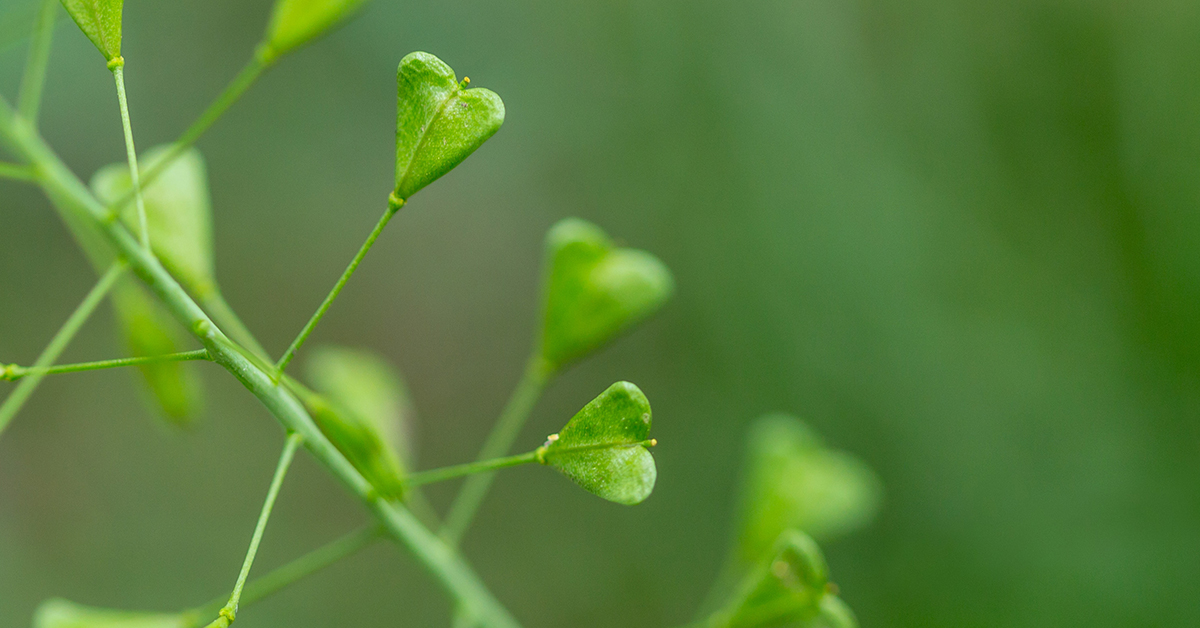In this monograph about shepherd’s purse:
📖 Introduction | 🌱 Botanical Description | 📜 Traditional Uses | 🔍 Phytochemistry | ✨ Applications and Uses | 🛡️ Safety Profile
📖 Introduction
Shepherd’s purse (Capsella bursa-pastoris) is a widely recognized plant in herbal medicine. It is known for its potent hemostatic and astringent properties. This humble weed, often overlooked, plays a crucial role in managing bleeding and improving urinary tract health.
| English Name | Shepherd’s purse |
| Latin Name | Capsella bursa-pastoris |
| Parts Used | Aerial parts |
| Traditional Uses | Bleeding, menstrual irregularities, urinary issues |
| Herbal Actions | Astringent, hemostatic, diuretic |
🌱 Botanical Description
Scientific Classification
Capsella bursa-pastoris is part of the Brassicaceae family and is closely related to cruciferous vegetables like broccoli and cabbage.
Physical Characteristics
This small annual plant features rosette-forming leaves and distinctive heart-shaped seed pods. It produces tiny white flowers on stalks that can rise above the foliage.
Natural Habitat and Cultivation Details
Native to Europe and parts of Asia, shepherd’s purse has become naturalized globally. It thrives in various environments, from agricultural land to urban settings, preferring well-drained soil and cooler climates.
📜 Traditional Uses
Historically, the shepherd’s purse has been utilized for its ability to stop bleeding quickly. It has been used both internally and externally to treat nosebleeds, heavy menstrual bleeding, and cuts. Its diuretic properties have also made it useful in traditional practices for treating urinary infections and kidney stones.

🔍 Phytochemistry (Active Constituents)
Shepherd’s purse contains several key phytochemicals contributing to its medicinal qualities:
- Biogenic amines: These compounds are crucial in the plant’s role in blood coagulation and vascular contraction.
- Flavonoids: Provide anti-inflammatory and antioxidant benefits, supporting vascular health.
- Tannins and Potassium salts: These contribute to the astringent and diuretic properties, aiding in fluid balance and reducing inflammation.
- Organic acids: Enhance the plant’s metabolic and healing properties.
✨ Applications and Uses
Shepherd’s purse is employed in various therapeutic areas, using its active components to address conditions related to bleeding, urinary health, and gastrointestinal stability.
- Hemostatic agent: Widely used to reduce bleeding in conditions such as menorrhagia and during minor surgical procedures.
- Urinary health: Its diuretic effect helps flush the urinary system, supporting kidney function and easing urinary infections.
- Digestive health: The astringent properties are beneficial in treating diarrhea and gastrointestinal bleeding.
🛡️ Safety Profile
Shepherd’s purse is generally considered safe for short-term use in recommended amounts.
However, due to its potent bioactive compounds, particularly those affecting coagulation, it should be used with caution in patients with clotting disorders or those on anticoagulant therapy.
Pregnant and breastfeeding women should avoid using shepherd’s purse due to insufficient safety data and its potential effects on the uterus.
As with any herbal remedy, it is advisable to consult a healthcare provider before starting treatment, especially for individuals with pre-existing health conditions or those taking other medications.
📃 Related Posts
🌱 Related Herbs

